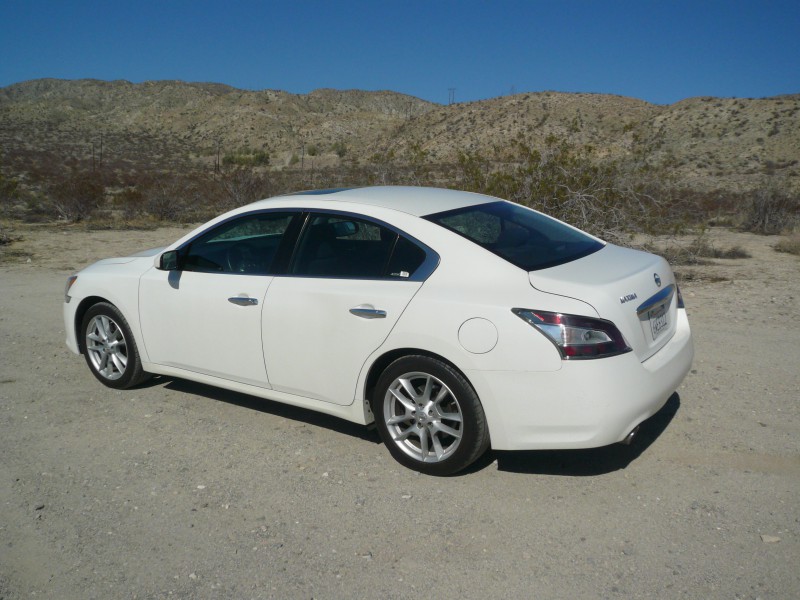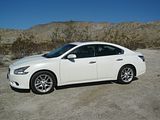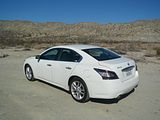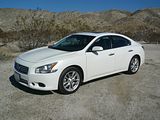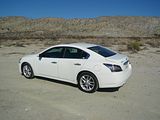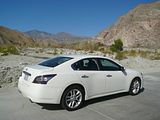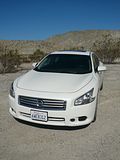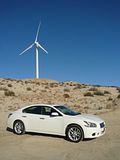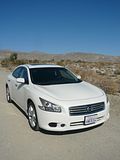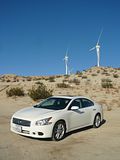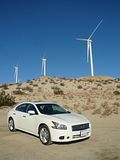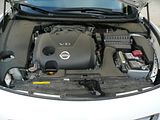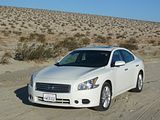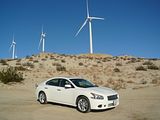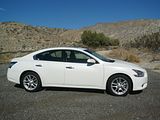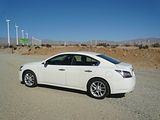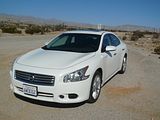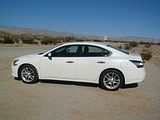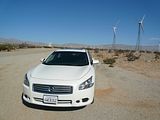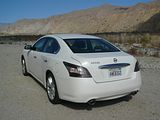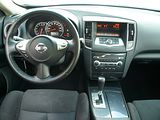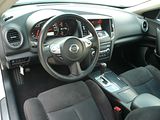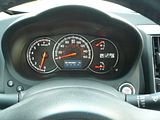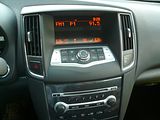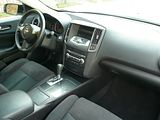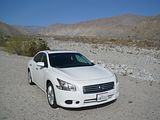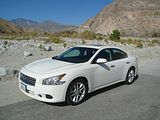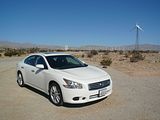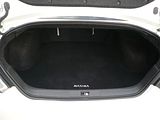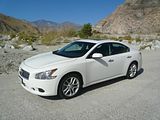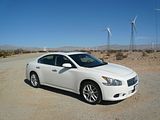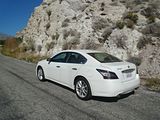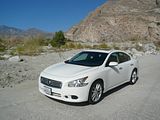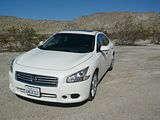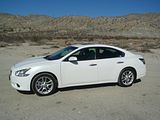
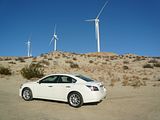
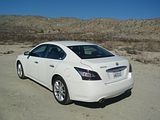
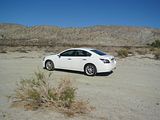
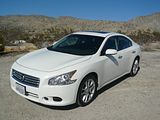
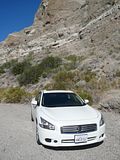
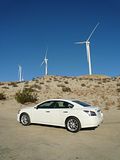
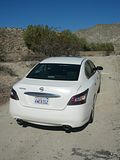
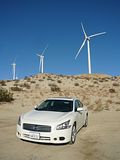
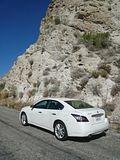

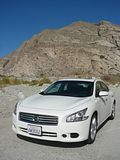
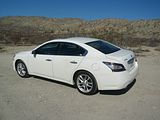
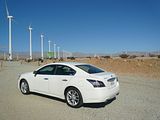
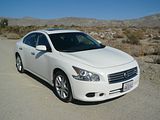
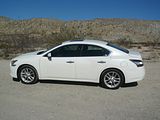
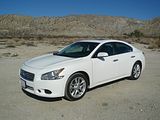
The name Maxima has been used by Nissan for over thirty years, during which time it has appeared on seven distinct successive models and as a model version on a few others as well. As is the case with most Japanese brands, once you start to delve into history, you find a level of complexity that is simply not there with the Europeans. The origins of the Maxima go back to 1977 when the once familiar rear-wheel drive Datsun Bluebird was given a longer front end to be able to fit in an in-line six cylinder engine. For the domestic Japanese market that meant a 2 litre unit, and for America, a 2.4 that was related to the powerplant in the popular 240Z. Americans were offered an Estate model, and later a Coupe as well as the Saloon version of what they knew as the Datsun 810. When a new Bluebird was presented in 1980, the six cylinder cars were separated to be a model in their own right, called Maxima, though in reality these were once more little more than Bluebird/910 cars with a longer front end and a six cylinder engine. Maxima has previously been used as a model name for a Japanese market only version of the Stanza, but it was now adopted in Japan and America for the G910 series car, which by 1984 shifted from being called a Datsun to a Nissan. In 1985, the Bluebird was restyled again, and made the transition to front wheel drive, and so the Maxima followed suit with the second generation car now falling in line with almost of the rest of the market. US customers still had the choice of a saloon or an estate, whilst the Japanese got the popular pillarless saloon option. Gradually more and more items of equipment were added to the model, so by the time of the launch of the third generation car in 1989, it had moved somewhat upmarket from the Ford Tempo and Chevrolet Corsica with which it had been competing, The third generation, J30, models were not sold in Japan, but they did come to Europe to replace the unlamented Laurel, and were pretty well received, selling in reasonable quantities, with their choice of 2 litre or 3 litre petrol engines. A fourth generation car arrived in 1995, and had another four year production run before the launch of the fifth model, By this time, the focus for this car was clearly North America, where the once closest rival Toyota Cressida had gone in a different direction, being replaced by the decidedly unsporting Avalon, and with a potent 3 litre engine this car won Motor Trend’s “Import Car of the Year” award on launch, Nissan were doing well promoting the car as an affordable sports luxury saloon, though it was offered in Europe as the Maxima QX, where it was seen as anything but sporting and sales were pitiful). To complicate things further, it was also sold as the Cefiro in Japan, replacing the previous rear wheel drive Cefiro. 2000 saw another refresh, with a new shape which was the first to be designed by Nissan in California, The engine was upgraded to a 3.5 litre in 2002. Now built in Tennessee unlike all its predecessors which came from Japan, the sixth generation car arrived in 2003, with this one being sold only in the USA, Canada and Mexico. A similar looking car was sold in Australia, called Maxima, but it was based on the Teana, and some other markets in Asia and the Caribbean had yet another variant called Cefiro. The seventh generation A35 model Maxima was premiered in 2008 at the New York Auto Show, going on sale as a 2009 model. I said it was complex! So, history lesson over, the important question is what the car is like. Nissan bill the Maxima as a “Four Door Sports Car”. Indeed there is a small sticker in the rear quarterlight making this proud boast. So, is this a legitimate claim, or marketing hyperbole?
Certainly when you fire up the Maxima, you get a very pleasant roar which sounds not unlike that of the late lamented 350Z, with which the car shares an engine. I’ve now driven a few Nissan and Infiniti models with this 3.5 litre V6, and although the exhaust systems mute the sound to a greater or lesser extent in all of them, they all generate what to me is a rather appealing noise. Maxima is not offered with a choice of engine – sole offering is the 3.5 ltire V6 developing 290 bhp – or transmission – you get the much derided X-tronic CVT whether you want it or not, but actually, no-one should feel short-changed by this, as there is little doubt that this powerplant is one of the strongest aspects of the car. Although that throaty roar that you get when you first fire up does diminish to something rather more muted, once you set off, you are in doubt that this engine means business. It is smooth and refined, but also energetic, and it endows the Maxima with a surprising level of acceleration if you work it hard. CVT gearboxes are not to everyone’s taste, and there are plenty out there which give the concept a bad name, but the one that is found here seems to do its job pretty well, being well co-ordinated with both the throttle and the brake, so there is none of the jerkiness that you sometimes encounter. There is a manual mode, which simulates a series of six defined ratios, and this can be used either with the wheel mounted paddles, or by pushing the lever back and forth in “S” mode. En route, noise levels proved to be generally low, with just a touch of wind noise evident at times, and the slight roar of the engine if you are accelerating hard. I had driven this Nissan quite a long way before the fuel needle even moved, and throughout the test, it continued to edge down only slowly. After driving 350 miles, I needed to put 13.73 gallons in to brim it, which computes to 25.5 mpg US, or 30.45 mpg Imperial, which I thought was a decent result for a car of this size and power.
A good engine is not sufficient to make for a “Sports Car” of course, as to make it enjoyable to drive, it needs to have good steering and handling characteristics, as well. Whilst a large saloon like this Nissan is never going to be as agile and nimble as a 350Z, they’ve actually done quite a sound job in making this car feel more sporting to drive than many of its rivals. For a start, the steering has plenty of feel to it, and the weighting is well judged, so you can tell exactly what the road wheels are going to do. And the handling and roadholding were good, so hustling the Maxima along twisty roads was an enjoyable experience, and a far cry from what you could expect from a Toyota or even a Buick. This is achieved without paying a penalty in the ride qualities, with the Maxima handling the varied and often poor surfaces of the Greater Los Angeles area’s roads with some aplomb. I never needed to test the brakes out in anger, but in everyday motoring, they were fine, with moderate pressure on the pedal delivering all the stopping that you would wish for. As with so many American market cars, there is a foot operated parking brake, released by pressing harder on the pedal. All round visibility proved to be OK, with a decent field of view from the door mirrors, though the angle of the rear window meant that you could not really tell where the back finished.
If there were no badges in the interior, anyone familiar with the house style would not take more than a couple of seconds to tell you that this is a Nissan, as it features a number of elements characteristic of the marque. Among these are the recessed display unit in the centre of the dash, flanked by vertically stacked air vents, with buttons, on a curving lower surface of the unit, the stubby column stalks and the particular design of the buttons on the steering wheel hub, along with the combination of Push Button Start and a slot for the key just above the driver’s left knee. Less characteristic of the marque these days is the hard plastics from which the main dash moulding appears to be made. Although the surface looks decent enough, when you touch it, it lacks the quality tactile feel that you would get in one of the German marques. It is primarily black, with chrome rings around the air vents, instrument dials and transmission selector. There are dark grey “wood effect” inlays on the lower half of the centre of the dash and around the gearlever. Combined with black seat trim and door casings, some may think the interior a little too sombre, but at least it avoids the temptation to look tawdry or overly fussy. There is a cowled binnacle which comprises three slightly intersecting instrument displays. A central speedometer is flanked by a rev counter on the left and on the right there are smaller gauges for fuel level and water temperature, with the odometer presented across the middle of this dial. A separate on board computer display is presented in the bottom part of the speedometer, and the different data points that it presents are selected by pressing a small button to the left of the steering wheel. The dials are all a model of clarity, nice and large, neatly marked, very easy to read and particularly clear at night. Column stalks operate the indicators and lights from the left and the wipers from the right. The centre of the dash contains the previously mentioned display unit which shows radio channel selected, ambient temperature and the climate control settings. Below this are a small number of knobs and buttons for the audio unit. Disappointingly, there is no satellite radio offered on this model, leaving me with the choice of AM or FM, wavebands and the need for frequent retuning. The leather covered steering wheel contains small buttons on the right for cruise control and on the left for changing audio channel and volume. There are only a few buttons, unlike the plethora that afflict some more recent designs. Indeed, that is a trade-off that Nissan will need to think about with the follow-on model. The infotainment set up feels definitely like it is from a previous generation, but the interior is unfussy and easy to use. For the next generation car, Nissan will need to modernise the former without losing the benefits of the latter.
It was not difficult to get comfortable in the Maxima. The driver’s seat has electric adjustment fore and aft and for the backrest and the height, and there is a ratchet lever to alter the angle of the seat. The steering column goes in and out as well as up and down, so once set I was happy, and the seat proved far more supportive than the shapeless chair on BA’s shiny new A380 that had brought me to Los Angeles the day before this test started. An electrically operated glass sunroof is a standard feature, but this does not rob the car of headroom at all, and with the cover open, you can let a lot more light into what otherwise was a rather black cabin. The seats are trimmed in a sort of box velvet type material, which is certainly a cut above the rather cheap material that features on a lot of cars these days, though many would doubtless expect to find leather in a model that the rental companies categorise as “Premium”. You need to pay for an SV model to get that, though.
Although built on the same platform as the Altima, the Maxima is a little larger, and so you would hope for that bit more space in it, and indeed that is what you get. Rear seat accommodation is not exactly class leading, but there is room for three adults, with ample space for the legs and shoulders. Headroom is less plentiful, though my head did not quite touch the roof, but it was close. There is a central fold down armrest, which has a pair of cup holders in its upper surface. The boot is disappointingly small, lacking length from front to back, width and height. There is more space available by folding down the rear seat backrests, though the opening through the rear bulkhead is not that sizeable, so whilst this will allow you to get some longer items in, it is not that helpful. There is negligible space under the boot floor around the spare wheel. Inside the cabin, as well as door bins on each door, there is a vast glovebox (something that Nissan seem to feature on all their cars and which other marques would do well to emulate), a bi-level stowage area under the central armrest, as well as smaller lidded cubby on the centre console in front of that armrest, which is where you will also find a pair of cupholders that sit under a lid, to the right of the gear lever.
With no choice around engine or transmission, there are just two different models of Maxima available – S and SV, with Sport and Premium packages which can be added to the SV as well as individual items from the options list. Rental spec Maxima all seem to be the cheaper S model. Standard equipment on this version includes an electric glass sunroof, dual zone automated climate control, an 8 speaker AM/FM/CD.MP3 audio unit with auxiliary power outlet, power operated driver’s seat with lumbar support, cloth seat trim, cruise control, vehicle anti-theft system, auto-off headlights, keyless start, front and rear reading lamps, a leather wrapped adjustable steering wheel with steering wheel controls, variable speed intermittent wipers, keyless entry, power door locks, an electrochromatic rearview mirror, a power driver mirror, illuminated driver and passenger vanity mirror. Costing nearly $5000 more, the SV adds xenon headlights, an upgraded 9 speaker Bose audio system with XM satellite radio, a vehicle information display with colour monitor, backup camera, leather seats. A few bucks under $2000 more gets you the SV Premium which adds a dual paned sunroof, premium mood lighting (!), atlantic cherry wood trim, and a power operated rear sunshade, power adjustment for the steering wheel, heated and cooled front seats, a memory system for the front seats, premium leather for the seats, and rear bucket seats for 3, The SV Sport is cheaper than the Premium, and adds 19″ dark silver finished alloy wheels, a rear spoiler and sports suspension to the SV spec, as well as premium leather trim, the heated and cooled front seats, the rear bucket seats, as well as the upgraded Bose audio unit.
Sharing a platform with the Altima and the second generation Murano, the Maxima remains an important car for Nissan US, with over 40,000 units sold in America, year to date. And based on my experience, that’s not an unreasonable number. It occupies a slightly hard to define position in the market, as it is neither large enough, nor “barge like” enough to compete against the Avalon or the LaCrosse, but it is more costly than the Camry/Accord/Fusion raft of models, whilst lacking the premium badging that is saved for Infiniti. Having no obvious rivals is not always a Good Thing, as it can mean the market does not know what to make of your product. I’ve read plenty that says the market does understand the Maxima and that it is overdue for a refresh (largely thanks to the old fashioned infotainment display screen!) and that it is a bit pricey. Both allegations have some substance, but actually, for me, it remains a good car. Perhaps that “Four Door Sports Car” label is stretching things a bit, but it was good to drive, and given the chance and the choice, I would happily take another one. When faced with an array of different cars, as is the case at a large US rental facility like Hertz’ LAX facility, willingness to have a repeat experience of a car is, for me, the acid test of whether it appeals or not. The Maxima does.

